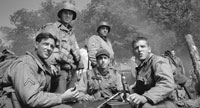P-51D Mustang IV

The P-51 was developed by North American Aviation, Inc. at the request of the British in 1940. The prototype, Model NA-73X, was developed in less than four months and tested in October of 1940. The plane entered production in 1941 and by mid-1942 active-duty combat planes were being flown by the Royal Air Force. Although the British initially named the fighter the "Apache," the name was eventually changed to "Mustang," a name that would later be added to the American P-51 designation.
Following the success of the design as a fighter/bomber with the RAF, the U.S. Army Air Force took a more active interest in the design and North American developed the P-51B, P-51C and P-51D variants. These variants soon saw extensive service in the USAAF in both the Pacific and European theaters. Although used for ground strafing and bombing of targets, the USAAF employed the Mustang primarily as a high altitude bomber escort because of its long range capabilities and impressive performance against the German Bf 109 and Fw 190 fighters.
For Operation Overlord all Allied aircraft were painted with a distinctive set of white and black stripes (known as "invasion stripes") designed to clearly mark friendly aircraft from those of the Germans. For fighters these stripes were to be 18 inches in width, and consisted of alternating stripes of white/black/white/black/white that were placed on the top and bottom of each wing, as well as encircling the rear body of the fuselage.
The P-51 was considered to be one of the best fighters produced during World War II, and even saw limited action in the Korean War as a ground-attack plane. The last documented use of the P-51 in combat was the 1969 conflict between Honduras and El Salvador.
Notes
The P-51Ds featured in Saving Private Ryan are "Big Beautiful Doll," a P-51 owned and operated by the Old Flying Machine Company of Cambridge, England, and "Old Crow," a P-51 owned and operated by Scandinavian Historic Flight. Neither of these planes are the originals, but are instead painted to resemble fighter craft of the past. SHF's "Old Crow" was built during WW2, but never flew in combat. For the film, "Old Crow" was flown by Mark Hanna, who died on September 26, 1999 following a plane crash.
"Big Beautiful Doll" has the markings of the 78th Fighter Group, while "Old Crow" is painted with 357th Fighter Group markings. Since the fighters appear so briefly in the film, it is difficult to tell exactly what type of paint job either craft had during the filming of the movie.
Fact vs. Fiction
A valid point of criticism is the absence of any attachment points on the wings for the bomb used to destroy the tank on the Ramelle bridge. Another problem with the Mustang's attack is the profile used during the bombing run. The Mustang appears to be employing a skip bombing technique instead of a more accurate dive bombing method. When skip bombing a pilot would be required to fly level and guess the point at which to release his bomb. Using this technique with friendly forces only feet away would be extremely risky.
While Private Ryan's use of the term "tank-buster" is not necessarily a phrase commonly used to describe the P-51, the Mustang was used in the ground-attack role. The P-51s liquid-cooled engine was more vulnerable to damage, thus the P-47 Thunderbolt (with a simpler air-cooled design) was a more likely choice to conduct ground-attack missions. It is possible that the SPR crew were unable to obtain the use of two P-47s, so they opted for a viable alternative.

